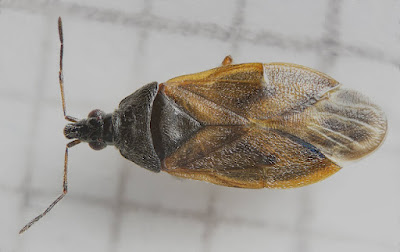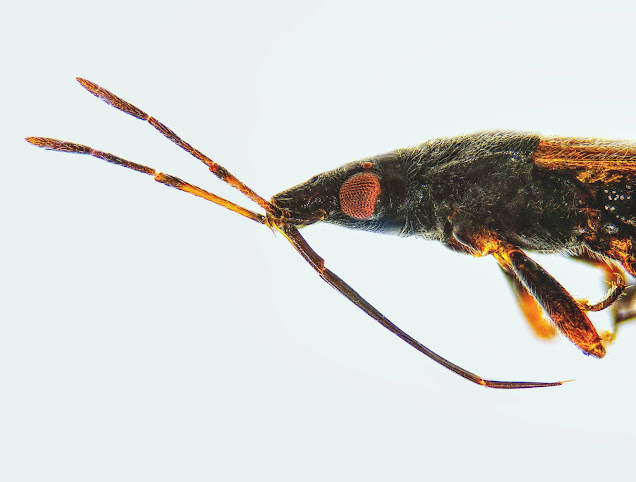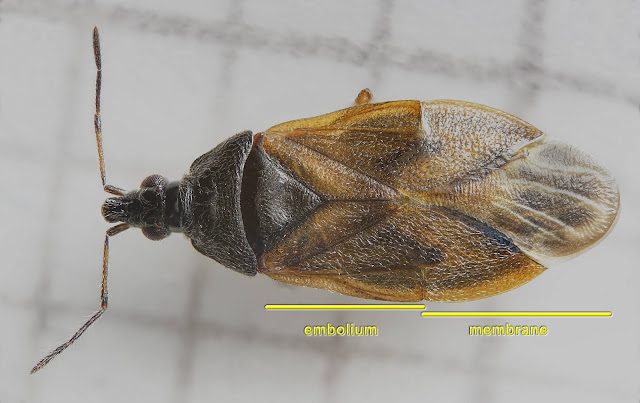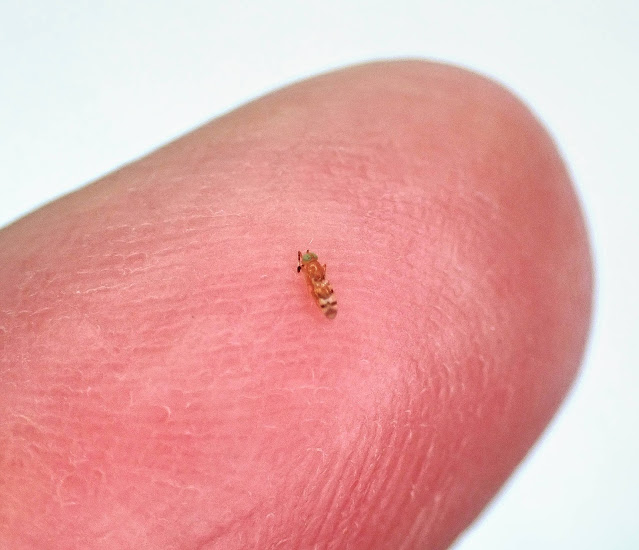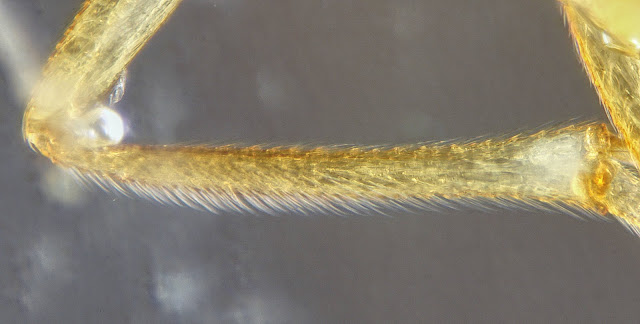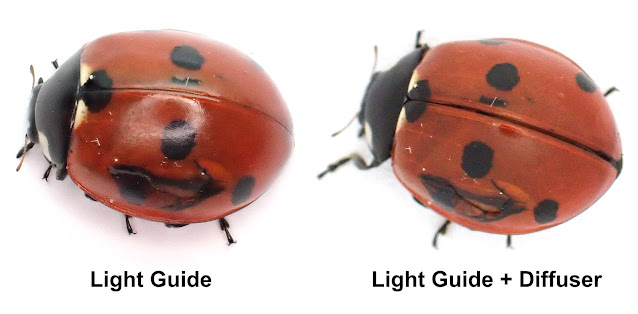Tuesday 23 April 2024
What the well-dressed entomologist is wearing this season
Wednesday 3 April 2024
Hawthorns Ahoy!
The Hawthorns in Leicestershire are just at the bud burst stage, and frankly looking a bit sparse still. Nevertheless, beating the emerging foliage is a good source for some interesting insects.
First is the charming little Lacebug Physatocheila dumetorum.
This favours Hawthorn but I have previously taken it from lichen-covered Larch, although the overwintering Larch specimen was very tatty. The Hawthorn this week was alive with these bugs, but the species is seriously under recorded, mostly because of the small size (2-3mm) I suspect.
If you spend some time on the Hawthorns, you'll also come across the Hawthorn Leaf Beetle, Lochmaea crataegi - an attractive bonus species!
Monday 1 April 2024
Entomology Journal - March 2024
March brought a few days when the birdsong and the warmth of the sun on my back felt like spring. Unfortunately, it also brought, in the words of Gilbert White "vast rain".
Solace from Gilbert White
March 9th 1775: Sad season for the sowing of spring-corn. Just such weather this time twelvemonths.
March 11th 1775: Vast rain. This rain must occasion great floods. The trufle-hunter came this morning, & took a few trufles: he complains that those fungi never abound in wet winters, & springs.
March 29th 1775: Ground covered with snow.
Stuck inside on many days when I would have liked to be out, I have taken solace from Gilbert White's diaries. While current climate change is absolutely unprecedented, I have been enjoying a "traditional" English spring, where the blossom and frogspawn appear on time, not weirdly early as they have in the subtropical, worryingly dry springs we have had in recent years. What will the summer bring?
There Is No Planet B
This was recommended to me in a discussion during a car share (I'd like to pretend I am that virtuous but for practical reasons I don't car share as much as I should). The first four chapters are life changing, or should be. I'm still digesting all the implications from this. Unfortunately this is a book of two halves; the second half wanders off into economics, ethics and politics and doesn't really contribute much as far as I was concerned. Still a must-read for those first four chapters.
Berners-Lee, M. (2021). There Is No Planet B: A Handbook for the Make Or Break Years-Updated Edition. Cambridge University Press.
My Journal, March 2024
01.iii.2024
Meteorological spring? Looked out of the window (wearing two fleeces) at the hail I think I'll wait for equinoctial spring. This comes on the day the Met Office announced February 2024 as the wettest on record. Things can only get wetter?
Quite a lot of the day spent discussing LNRS species lists. I wonder how LRNS will be regarded in 100 years time...
02.iii.2024
March weather continues to be meh, so more hibernation over the microscope, punctuated by LNRS pondering.
03.iii.2024
Now that "spring" is here, it's good to welcome the return of winter, with significant frost for two nights now. Sunny and dry. Viburnum Cushion Scale larvae - Lichtensia viburni - very abundant on Ivy.
04.iii.2024
Another good frost. After the thaw, a chilly visit to Shady Lane to tickle the conifers, serenaded by flocks of Goldcrests. Lots of ladybirds and some very nice leafhoppers, the highlight being Viridicerus ustulatus, the first record for VC55.
05.iii.2024
Today we ran a live NatureSpot Zoom session, the first time since the Recorder's Meeting last year. Judging by the email feedback it was popular. Felt a bit like being back in lockdown - am I getting sentimental? :-)
07.iii.2024
An Anthocoris afternoon, sorting the butleri from the nemoralis.
08.iii.2024
Spent the morning tackling the overgrown section of hedge before the birds start nesting. Ivy and Dogrose has great wildlife value but it's a potent combination when it comes to pruning. Found one old nest (Blackbird I think), Common Plume and Nigma walckeneri. In the afternoon, dentist. I preferred tackling the Dogrose.
09.iii.2024
A muddy slog up Bardon Hill to try out my new beating umbrella. The yield was underwhelming after overnight rain, with the exception of a single Tephritis matricariae, beaten from conifers (the third record for VC55, my first).
Returning home, things got better. On 26th January 2022 I was refurbishing a pond in my garden when I found a single female spider which, after investigation, turned out to be Megalepthyphantes sp. near collinus. Quite a mouthful (because it still lacks a formal description and naming), so Megalegs for short. This record was a big range expansion for this new spider. And ... that was it. I have not found any more specimens, and neither has anyone else in VC55. Until, that is, opening my dustbin I found another female on the inside of the lid. To find one spider may be regarded as fortunate; to find two looks like there is a colony in my garden. The bin was crammed with hedge prunings from the previous day, which is where the spider must have come from. I look forward to future sightings.
11.iii.2024
Wet. Microscope. Anthocoris.
12.iii.2024
Wet. Microscope. Anthocoris. First frogspawn in the garden for years, since Ranavirus wiped my garden population out. Will they survive the newt attack?
14.iii.2024
Finished the last of the Anthocoris archive samples with a whole load of A. confusus. Great to be able to work through plenty of specimens and build confidence.
16.iii.2024
Took advantage of the sunny start to go up Billa Barra and beat the pines and Gorse. Lots of bird song. Not too much found except for thrips in the Gorse. So many thrips! When I opened my glasses case it was full of them. They found body cavities I didn't know I had, but the ears were the worse.
17.iii.2024
After an atrocious start to the day the afternoon felt the most springlike yet, with many insects sunning themselves and the first garden Brimstone.
Sorting through the samples from yesterday I found three more Acampociris alpinus. So far I have found this wherever I have looked on Scots Pine. It would be so easy to attribute this flush of records to climate change but the truth is that the season is taxonism - you can bet those pines have been gone over for beetles and moths, but no-one cared much about bugs.
19.iii.2024
Attended the first 2024 field meeting of the Leicestershire & Rutland Hemiptera Society at Moira Furnace. A few bugs found, the highlight of which was Physatocheila dumetorum on lichen-covered Larch, followed by a meeting of the Publications Committee and the Anthocoridae Subcommittee. Felt very spring-like.
20.iii.2024
To celebrate the vernal equinox the garden Robin started belting it out in pitch dark at 4.35am. Hormones are running high.
23.iii.2024
For some time I have been working on an aquatic macro photography setup. My first two efforts crashed and burned, or to be more accurate, leaked. The third attempt is functional but not perfect. Fished a Large Red Damselfly nymph out of one of my ponds to test it. Now to find some aquatic bugs! More details here: Twenty Thousand Leagues Under the Duckweed
26.iii.2024
Out early to Billesdon in the sunshine. Beyond the ravaged hedges struggling to green up, a Skylark sang. First pond dipping session of the year. Aquatic Homoptera a bit limited but I was able to refresh my memory of a few species.
30.iii.2024
A sunny but muddy trip to Croft Pasture. I have never seen the Soar as high and it has made new braided channels across the meadow. Worked unsuccessfully for half an hour without finding any aquatic bugs, but eventually found out where they were all hiding in a sheltered bay by the railway bridge.
Walking back across the road bridges there was a good range of insects sunbathing on the verge. Spring at last?
Wednesday 27 March 2024
Twenty Thousand Leagues Under the Duckweed
This season I planned to work out an aquatic macro photography setup to take more naturalistic habitus photos of aquatic bugs. My first two efforts crashed and burned, or to be more accurate, leaked. The third attempt is functional but not perfect. The setup consists, simply, of a small transparent food storage box:
My first trial was with a Large Red Damselfly nymph, Pyrrhosoma nymphula, which I fished out of one of my ponds as a test subject. It behaved nicely and I got some reasonable photos, although the quality is not outstanding:
I then moved on to the bugs I planned to photograph, which is where things fell apart. I did get a photo of the rear end of Notonecta viridis, but this shows up the defects in the setup:
Because the subject is close to (touching) the front of the tank, you can see the distortion from the plastic walls in this macro shot, even though the box looks quite clear when I hold it up to the light. This also results in loss of image quality from subjects in the middle of the tank, even though I am not focussed on the front. But then it got worse. I ran into a major problem trying to photograph Corixids. I discovered that Corixids will only pause having rammed themselves into plants or gaps, making it impossible to get clear shots. In a bare container, they just continue to swim manically. So it's back to the old setup, simply photographing Corixids from above in a shallow white ceramic dish of water:
I'll hang on to my cheap plastic setup which will get used occasionally for co-operative subjects.
Sunday 10 March 2024
The Return of Megalegs
On 26th January 2022 I was refurbishing a pond in my Leicester garden when I found a single female spider which, after investigation, turned out to be Megalepthyphantes sp. near collinus. Quite a mouthful that (because it still lacks a formal description and naming), so Megalegs for short. This record was a big range expansion for this new spider. And ... that was it. I have not found any more specimens, and neither has anyone else in VC55. Until, that is, Saturday 9th March 2024, when, opening my dustbin I found another female on the inside of the lid. To find one spider may be regarded as fortunate; to find two looks like there is a colony in my garden. The bin was crammed with hedge prunings from the previous day, which is where the spider must have come from. I look forward to future sightings.
Thursday 29 February 2024
Entomology Journal - February 2024
If you'd like to receive free montly updates via email, please let me know.
Although February's weather continued to be challenging, the month turned out to be unexpectedly productive, including the first record of a new genus for VC55.
Beetles and Barnacles
I spent a lot of February furtling around in Ivy, so for a change I decided to go and bother some local conifers. This turned out to be surprisingly productive, turning up lots of Ladybirds and Bugs, but also a few Beetles. I managed to identify the quite distinctive Cartodere bifasciata without too much trouble, but this 2mm beetle was another story. The Facebook Beetles of Britain and Ireland group was able to confirm that it is Cryptophagus, but Clive Washington warned me that there was trouble ahead. After looking at the key, I decided to give up fairly quickly. It is comforting to know that Darwin felt challenged in much the same way about Barnacles as I do about Beetles (albeit he was far more competent). This has been well and entertainingly documented by Rebecca Stott (Darwin and the Barnacle. (2004) New York: Farber & Farber) - recommended reading. Good to know that Darwin had similar problems with microscope dissections (specimens pinged across the room) as I do (although bugs not barnacles in my case).
My Journal, February 2024
01.ii.2024
Back to the churchyard for a few more Microterys seryon, then spent a while taking photos of the hairs on the leg of a 2mm wasp. Entomology!
02.ii.2024
Hedge pruning on a warm and sunny afternoon. The Pulmonaria is out and the Hairy-footed Flower Bees can't be far behind. I always think of Maggie Frankum when the Pulmonaria flowers.
03.ii.2024
A short trip to Billesdon on a warm morning. Sadly the tidy brigade blitzkrieg has reduced the wildlife value of the site. Sifted a range of things from moss.
05.ii.2024
Finished the samples from Billesdon. A surprising range of arthropods hunkered down in the moss.
06.ii.2024
A brief, very breezy and quite unproductive visit to Lucas's Marsh before the rain.
07.ii.2024
Working on some samples that were sent to me when the thing I hate happened. An interesting bug I didn't recognise pinged off the stage and dematerialized. Why does it only happen with the good ones?
09.ii.2024
Unremitting rain. In the ongoing battle of water table versus lawn water table comes out on top. The ephemeral stream that runs through the posh houses is up for the first time this winter.
12.ii.2024
Biodiversity Net Gain is here. I wish I could be positive about this but I'm not. Possible gains 30 years in the future but no hope of it being monitored or enforced. We can't even look after existing SSSIs. On the plus side, a territorial Wren singing in the garden. Sorry spiders!
13.ii.2024
Out early(ish) this morning for some local Ivy-bothering. Didn't quite beat the rain but was surrounded by enough birdsong to make it feel like spring.
15.ii.2024
15C and it feels like spring. Lots of birdsong and a productive session beating conifers. Brimstone Butterflies on the wing all over the County. Some local conifers proved to be very interesting, and I found a single Acompocoris alpinus - the first VC55 record for this genus. Very pleased!
16.ii.2024
Buoyed with enthusiasm by yesterday's weather I ran the moth trap for the first time this year. Sadly, it was chillier (6C) and windier than I had hoped and the moths stayed away. A few years ago I would have expected a few moths at this time of year, but moths in my suburban garden have massively declined. The Met office published data showing that the average UK winter has become around 1C warmer and 15% wetter over the past century. Six of the 10 warmest winters on record were in the 21st century, and four of these also rank in the top 10 wettest years on record.
19.ii.2024
A short trip to the local park to beat conifers was very successful. I hadn't remembered there were as many Scots Pines there. These proved to be very productive, yielding 10 species of ladybird: 7 Spot Ladybird, 10-spot Ladybird, 18 Spot Ladybird, Cream-streaked Ladybird, Epaulet Ladybird, Eyed Ladybird, Harlequin Ladybird, Larch Ladybird, Pine Ladybird, Scymnus suturalis. Unexpectedly, this is turning into the Year of the Ladybird. In addition to this I also found another female Acompocoris alpinus. A very good outing.
21.ii.2024
Worked on springtails I was given from pitfall traps. Was reminded what a taxonomic mess the genus Isotomurus is!
22.ii.2024
Another miserable day so more pickled pitfall springtails. Coal Tits are competing with the Great Tits for one of the garden nest boxes.
23.ii.2024
Working through some 2023 Anthocoridae specimens I was given. They're a challenge but I do feel confident with this group now.
24.ii.2024
Spent the morning messing about with a Harlequin Ladybird infected with Hesperomyces harmoniae I found in the bedroom. Very enjoyable! Also agreed to do my first talk on ladybirds and lead a ladybird walk. Ladybirds ladybirds ladybirds!
In the afternoon I took advantage of the sunshine for a quick trip to the Botanical Garden where I found some nice leafhoppers overwintering on conifers, Metidiocerus rutilans and Balclutha punctata.
26.ii.2024
Visited a private Charnwood rewilding project to do some sampling. Nice day but cold. A good range of invertebrates via the vacuum sampler.
27.ii.2024
Charnwood invertebrate sorting. Cold, but the Marsh Marigolds in our bog are out.
28.ii.2024
Meeting at County Hall discussing Local Nature Recovery Strategy. In the afternoon I huddled over a nice warm microscope looking at spiders from Monday's site visit.
29.ii.2024
Happy Leap Day! I celebrated by staying out of the rain. February seems determined to finish as the wettest on record (close now). Sweet Violets are out on the remnant verge by the posh houses.
Sunday 25 February 2024
Harlequin Rot
Yesterday in my bedroom I found a Harlequin Ladybird, Harmonia axyridis, so I took a few record photos and noticed tufts of yellow Laboulbenia-type fungus growing on it. Dredging my memory, I recalled something about a fungus on Harlequin Ladybirds so I took a closer look. Our County Recorder kindly informed me that the fungi on Coccinellidae are Hesperomyces harmoniae, which is actually a species complex, each clade seemingly host-species specific. The fungus on Harmonia axyridis is Hesperomyces harmoniae (Haelewaters, D. (2019). Hesperomyces “harmoniae” nom. prov.(Laboulbeniales), an ectoparasitic fungus specific to Harmonia axyridis. IOBC-WPRS Bull, 145, 53-55)
I took a few of the yellow thalli examined them under the microscope:
Laboulbeniales form individual thalli but lack vegetative hyphae. The haustorium penetrates the tissues of the host so that they can reach to the body cavity and draw nutrients from the haemolymph. Hesperomyces fungi are only transferred when ladybirds are in close contact with each other, during overwintering or mating. Infected Ladybirds do not die but may have a shorter lifespan or a reduced ability to produce as many eggs as normal.
Saturday 24 February 2024
If you can't stand the heat ... you're in trouble
Wednesday 21 February 2024
A Loveliness of Ladybirds
10 species - all from one Scots Pine:
7 Spot Ladybird, 10 Spot Ladybird, 18 Spot Ladybird, Cream-streaked Ladybird, Epaulet Ladybird, Eyed Ladybird, Harlequin Ladybird, Larch Ladybird, Pine Ladybird, Scymnus suturalis.
Monday 19 February 2024
Acompocoris alpinus
Trying to avoid the flooding on a recent field outing I stayed local and decided to beat a few conifers near my home. This produced a good range of beetles, especially ladybirds (why did we ever think Rhyzobius chrysomeloides was rare?), and bugs. The bugs included a few shieldbugs but I focussed on my favourite, the Anthocorids. On getting home and drying out I sorted the catch and was pleased to find what I immediately recognized as an Acompocoris.
There were no VC55 records for this genus, but with only two species on the UK Checklist, how hard could it be? (UPDATE: Previous records have subsequently come to light)
In Acompocoris alpinus the length of the membrane posterior to the embolium is at least two-thirds the length of embolium, while in Acompocoris pygmaeus the length of membrane posterior to tip of embolium is less than two-thirds the length of embolium. That makes this A. alpinus, which fits with the overall habitus and the locale (A. alpinus is found on a range of conifers while A. pygmaeus is said to be associated with Scots Pine).
Jim Flanagan was kind enough to confirm my I.D., so we now have one VC55 record for the genus. Now to find some more (preferably males)! Both species feed on aphids so the next few months is a good time to look for them.
Friday 2 February 2024
Microterys
There are three species of Microterys, parasitic Encyrtid wasps, in the UK. They are tiny which accounts for them usually being overlooked. They parasitise scale insects and have been widely used as biocontrol agents. The males are difficult to identify but the females, although similar, can be identified with a microscope. I recently found large numbers of Microterys seyon overwintering in Ivy. Although tiny (around 2mm), they are distinctive in appearance and stand out in the beating try. Even in the cold they have a tendency to high speed vertical takeoff, so you'll need to be nimble to catch them.
- Microterys nietneri and Microterys seyon are similar in appearance with strongly patterned wings and black and white antennae. The middle tibia of Microterys seyon is covered in silky hairs which are not present in M. nietneri.
- Microterys tricoloricornis is larger (nearly twice the size, around 4mm) and slightly darker than the other two species.
See: Painter, D. (2020). Two parasitoid wasp species, Microterys tricoloricornis and Microterys nietneri (Hymenoptera: Chalcidoidea, Encyrtidae), new to Britain. British Journal of Entomology and Natural History, 33, 1-16. Available here.
Thursday 1 February 2024
Entomology Journal - January 2024
If you'd like to receive free montly updates via email, please let me know.
January has been a quiet month entomologically. The weather suggested staying indoors and reading. I have cleared and submitted all my 2023 records.
Cryptic Confusion
I get a lot of Rhyzobius litura ("Meadow Ladybird") in vacuum samples and a fair number of Rhyzobius chrysomeloides ("Epaulet Ladybird") from beating evergreens. As with so many species, "typical" specimens are easy to recognize, but many are poorly marked and in my experience the dorsal pigmentation patterns of the two species overlap. Apart from habitat (terrestrial versus arboreal) I had been relying on the shape of the prosternal keel to separate them, but I recently learned that this is unreliable. Andrew Jewels has an excellent web page on these species and suggests using pronotum shape as well as pigmentation to identify them. Thank you Andrew! See: https://www.andrewjewels.com/pointed-v-round
Warning: Not Arthropod-related, but seasonal: Killing with kindness: should we be feeding birds?
Some eye-opening facts: Providing wildlife with food, water, shelter and manufactured nesting sites is multi-billion-dollar industry - follow the money; over 17 million UK households spend a combined £250 million on more than 150,000 tonnes of bird food annually, sufficient to feed three times the entire breeding populations of the ten commonest feeder-using bird species year-round if they consumed nothing else; there is an average of 100 bird feeders per square kilometre equating to one feeder per nine feeder-using birds nationally.
Killing with kindness: Does widespread generalised provisioning of wildlife help or hinder biodiversity conservation efforts? (2021) Biological Conservation, 261, 109295: https://e-space.mmu.ac.uk/628250/1/Wildlife_provisioning_BiolCon_R2_tracked_acl.pdf
Reading Matter
The weather has encouraged me to do a lot of reading this month. Roy, H. & Brown, P. (2018) Field guide to the ladybirds of Great Britain and Ireland, has been very useful and I recommend it, even though I have not done as much ladybird-biothering as I would have like to this month.
I finally got around to reading Kim Stanley Robinson (2020) The ministry for the future. Science fiction is not everyone's taste but Kim Stanley Robinson is arguably not a sci-fi writer, having a track record in cli-fi. I'm growing increasingly irritable about the lack of action on the climate crisis and KSR's call to (radical) action has made me think. Recommended.
My Journal, January 2024
01.i.2024
A welcome sunny morning to start the year. Went to look for Leiobunum sp. A - unsuccessfully. Not surprising as it is late in the year and after the recent weather. One to return to in the autumn.
02.i.2024
Latest month was the wettest ever December in Leicestershire and today Storm Henk is dropping more rain. River levels along the Soar corridor at record highs. Both of my ponds have overflowed and the garden is flooded across the entire width. In 35 years I have never seen this before. It will take some years to understand the impact it two wet winters on insect populations. At lunchtime a disconsolate looking fox turned up and splashed around in the puddles before eventually managed to get over the slimy fence, an obstacle they normally clear at a single leap.
03.i.2024
My first talk of the year (on bugs) to Leicester Lit & Phil. Good audience and very enjoyable.
04.i.2034
The garden flood has abated but the ground is saturated. In the afternoon a Leicestershire & Rutland Entomological Society Committee meeting - planning for the future.
05.i.2024
Walked round Knighton Park to see the filled flood basins. I'm always sad that these could not be permanent wetland basins rather than football pitches. Lots of springtails and hats off to the aeronauts! It stops raining for 5 minutes and Erigone are everywhere trying to balloon. Mostly E. atra with the odd E. dentipalpis.
06.i.2024
Worked on a few samples that were sent to me. Good to be active.
07.i.2024
Walked to Ingarsby. The lane is in a terrible state with water and traffic damage. A male Bullfinch sunlit against a dark sky. A variety of Arthropods in the Ivy, but giving a feeling of scarcity rather than abundance.
08.i.2024
The Met office Published rainfall figures for last year. 2023 was 11% wetter than average for the UK, but not in the top ten wettest on record. However, October-December was more than 50% wetter than the average in Leicestershire. Does this justify me writing about the weather *again*?
10.i.2024
Things still very slow entomologically. Two Wooly Jumpers (Pseudeuophrys lanigera) on the bedroom ceiling.
12.i.2024
Treated myself to a copy of Helen Roy's Field Guide to Ladybirds of Britain & Ireland. I can justify this by regarding them as honourary Hemiptera rather than Coleoptera!
13.i.2024
A nice sunny walk at Ulverscroft. Entomology was a bit sparse but plenty of Gorse Shieldbugs. Ladybirds limited to 7 Spot and Orange. Tephritis bardanae in the Gorse was a new species for me. Should I become a dipterist? Nah!
15.i.2024
Spent a very cold day revisiting Croft spiders from June. One of the pleasures of winter is preserving summer in 70% alcohol. CEH published December river flow surveys, Soar at 210% of 1991-2000 average. There will be major impacts on insects but what will they be? Inconsistency for year to year is a major issue.
16.i.2024
Revisited spider specimens from Rocky Plantation in May. At the time I wasn't over impressed with the total, but in the depths of January they look much better.
18.i.2024
Still frozen solid outside so I revisited spiders from the ancient Oaks in Bradgate Park last May.
20.i.2024
Neriene montana in the kitchen first thing. Always good to get the first spider of the day under your belt before breakfast. Finally a slight thaw so time for tree planting. Several years ago we planted a mixed native hedge which is slowly establishing, surviving droughts, record heatwaves and flooding. All except the Alder Buckthorn, which grew backwards and finally died (soil not acid enough?). The other problem was a Goat Willow which turned out not to be - very strappy leaves. So Alder Buckthorn has been replaced by a new Goat Willow from a different supplier. Fingers crossed.
21.i.1024
Another named storm, so I sorted out the bug samples from the Allerton Project Rothamstead trap. Mostly Red-legged Shieldbugs.
26.i.2024
A week of meetings. Finally a dry day with no named storm so up the ladder to clear out the nestboxes. Pleased to find the Great Tit nest I feared failed had in fact fledged. Not sure what they lined it with, coarse wool-like stuff with long fibres. No sheep around here! Nest was entomologically disappointing, one Lace Weaver, Amaurobis similis, was all.
27.i.2024
An unproductive walk around Martinshaw. Admired. The new lake (blocked culvert). Skylark nearly drowned out by the motorway.
28.i.2024
Worked on samples from Wardley Wood last May. The 2023 backlog is nearly gone, which poses a problem for February.
29.i.2024
All 2024 records processed and submitted. Just managed to squeeze past 100 spider species for the year. What am I going to do now?
31.i.2024
Accepted my first talk booking for 2025! Also poked around in the churchyard Ivy, finding the expected cryptic ladybirds and lots of Microterys seyon, a stunning but tiny parasitic wasp.
Tuesday 30 January 2024
Charnwood Confusion Continues
Monday 22 January 2024
A simple (and cheap) macro diffuser for Olympus TG cameras
Photography - it's all about the lighting (the clue is in the name).
Olympus TG cameras are great for macro photography. Working at very close range can be difficult, often blocking the light needed to illuminate the subject. The Olympus TG Light Guide is a very helpful (if over-priced) accessory which directs light from the front LED in a circular ring light-fashion onto the subject. This is useful but can be a problem when taking macro photos of shiny subjects. The clear plastic at the front of the TG Light Guide does not provide much in the way of diffusion, causing a bright ring-shaped hot spot on images:
The diffuser consists of a white plastic pudding cup. I bought mine online but you could probably find something which would do the job in the dessert section of the supermarket (note: eat pudding before use). Turn the cup upside down and place the Light Guide on the top of the cup, draw around the inside of the lens hole in the Light Guide and cut out a hole (you can do it less crudely than I did, but mine still works fine).
To use, place the subject under the cup, put the camera (with the Light Guide) on top, compose and take your photos. The remaining rim of the cup covers the clear ring of the Light Guide and diffuses the LED further, reducing hot spots on the subject. The cup also acts as a copy stand which reduces camera movement when using the focus stacking functions of the camera.
It's cheap, it works, and you get to eat pudding. What's not to like?














